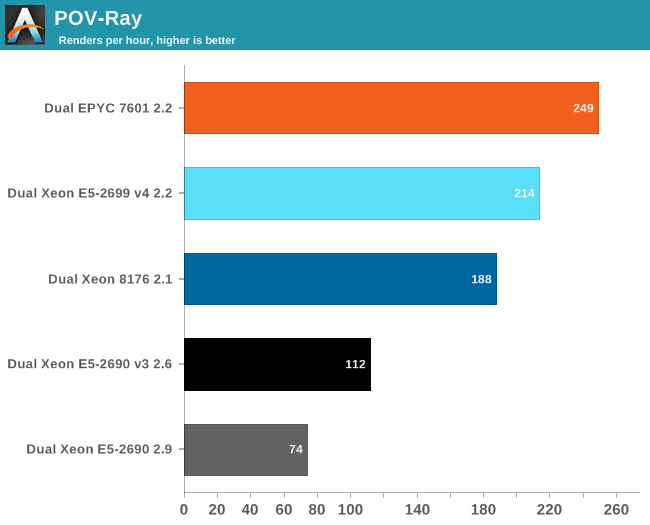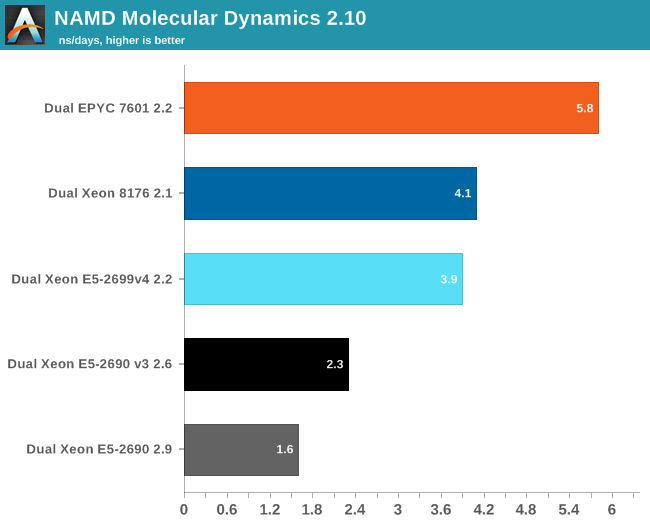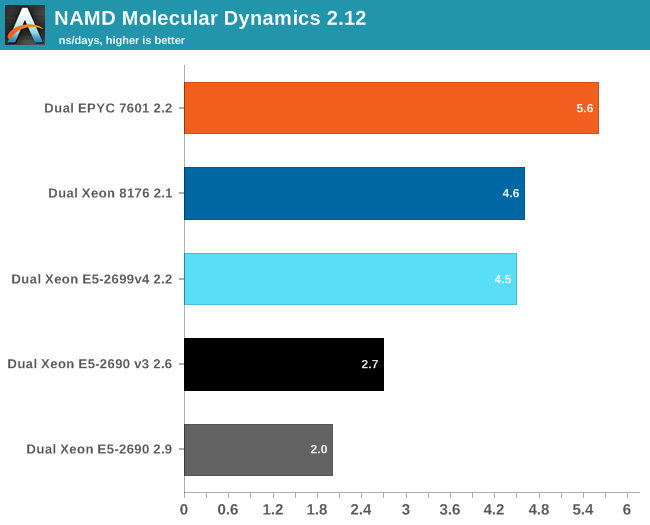Sizing Up Servers: Intel's Skylake-SP Xeon versus AMD's EPYC 7000 - The Server CPU Battle of the Decade?
by Johan De Gelas & Ian Cutress on July 11, 2017 12:15 PM EST- Posted in
- CPUs
- AMD
- Intel
- Xeon
- Enterprise
- Skylake
- Zen
- Naples
- Skylake-SP
- EPYC
Floating Point
Normally our HPC benchmarking is centered around OpenFoam, a CFD software we have used for a number of articles over the years. However, since we moved to Ubuntu 16.04, we could not get it to work anymore. So we decided to change our floating point intensive benchmark for now. For our latest article, we're testing with C-ray, POV-Ray, and NAMD.
The idea is to measure:
- A FP benchmark that is running out of the L1 (C-ray)
- A FP benchmark that is running out of the L2 (POV-Ray)
- And one that is using the memory subsytem quite often (NAMD)
Floating Point: C-ray
C-ray is an extremely simple ray-tracer which is not representative of any real world raytracing application. In fact, it is essentially a floating point benchmark that runs out of the L1-cache. Luckily it is not as synthetic and meaningless as Whetstone, as you can actually use the software to do simple raytracing.
We use the standard benchmarking resolution (3840x2160) and the "sphfract" file to measure performance. The binary was precompiled.

Wow. What just happened? It looks like a landslide victory for the raw power of the four FP pipes of Zen: the EPYC chip is no less than 50% faster than the competition. Of course, it is easy to feed FP units if everything resides in the L1. Next stop, POV-Ray.
Floating Point: POV-Ray 3.7

POV-Ray is known to run mostly out of the L2-cache, so the massive DRAM bandwidth of the EPYC CPU does not play a role here. Nevertheless, the EPYC CPU performance is pretty stunning: about 16% faster than Intel's Xeon 8176. But what if AVX and DRAM access come in to play? Let us check out NAMD.
Floating Point: NAMD
Developed by the Theoretical and Computational Biophysics Group at the University of Illinois Urbana-Champaign, NAMD is a set of parallel molecular dynamics codes for extreme parallelization on thousands of cores. NAMD is also part of SPEC CPU2006 FP. In contrast with previous FP benchmarks, the NAMD binary is compiled with Intel ICC and optimized for AVX.
First, we used the "NAMD_2.10_Linux-x86_64-multicore" binary. We used the most popular benchmark load, apoa1 (Apolipoprotein A1). The results are expressed in simulated nanoseconds per wall-clock day. We measure at 500 steps.

Again, the EPYC 7601 simply crushes the competition with 41% better performance than Intel's 28-core. Heavily vectorized code (like Linpack) might run much faster on Intel, but other FP code seems to run faster on AMD's newest FPU.
For our first shot with this benchmark, we used version 2.10 to be able to compare to our older data set. Version 2.12 seems to make better use of "Intel's compiler vectorization and auto-dispatch has improved performance for Intel processors supporting AVX instructions". So let's try again:

The older Xeons see a perforance boost of about 25%. The improvement on the new Xeons is a lot lower: about 13-15%. Remarkable is that the new binary is slower on the EPYC 7601: about 4%. That simply begs for more investigation: but the deadline was too close. Nevertheless, three different FP tests all point in the same direction: the Zen FP unit might not have the highest "peak FLOPs" in theory, there is lots of FP code out there that runs best on EPYC.










219 Comments
View All Comments
oldlaptop - Thursday, July 13, 2017 - link
Why on earth is gcc -Ofast being used to mimic "real-world", non-"aggressively optimized"(!) conditions? This is in fact the *most* aggressive optimization setting available; it is very sensitive to the exact program being compiled at best, and generates bloated (low priority on code size) and/or buggy code at worst (possibly even harming performance if the generated code is so big as to harm cache coherency). Most real-world software will be built with -O2 or possibly -Os. I can't help but wonder why questions weren't asked when SPEC complained about this unwisely aggressive optimization setting...peevee - Thursday, July 13, 2017 - link
"added a second full-blown 512 bit AVX-512 unit. "Do you mean "added second 256 ALU, which in combination with the first one implements full 512-bit AVX-512 unit"?
peevee - Thursday, July 13, 2017 - link
"getting data from the right top node to the bottom left node – should demand around 13 cycles. And before you get too concerned with that number, keep in mind that it compares very favorably with any off die communication that has to happen between different dies in (AMD's) Multi Chip Module (MCM), with the Skylake-SP's latency being around one-tenth of EPYC's."1/10th? Asking data from L3 on the chip next to it will take 130 (or even 65 if they are talking about averages) cycles? Does not sound realistic, you can request data from RAM at similar latencies already.
AmericasCup - Friday, July 14, 2017 - link
'For enterprises with a small infrastructure crew and server hardware on premise, spending time on hardware tuning is not an option most of the time.'Conversely, our small crew shop has been tuning AMD (selected for scalar floating point operations performance) for years. The experience and familiarity makes switching less attractive.
Also, you did all this in one week for AMD and two weeks for Intel? Did you ever sleep? KUDOS!
JohanAnandtech - Friday, July 21, 2017 - link
Thanks for appreciating the effort. Luckily, I got some help from Ian on Tuesday. :-)AntonErtl - Friday, July 14, 2017 - link
According to http://www.anandtech.com/show/10158/the-intel-xeon... if you execute just one AVX256 instruction on one core, this slows down the clocks of all E5v4 cores on the same socket for at least 1ms. Somewhere I read that newer Xeons only slow down the core that executes the AVX256 instruction. I expect that it works the same way for AVX512, and yes, this means that if you don't have a load with a heavy proportion of SIMD instructions, you are better off with AVX128 or SSE. The AMD variant of having only 128-bit FPUs and no clock slowdown looks better balanced to me. It might not win Linpack benchmark competitions, but for that one uses GPUs anyway these days.wagoo - Sunday, July 16, 2017 - link
Typo on the CLOSING THOUGHTS page: "dual Silver Xeon solutions" (dual socket)Great read though, thanks! Can finally replace my dual socket shanghai opteron home server soon :)
Chaser - Sunday, July 16, 2017 - link
AMD's CPU future is looking very promising!bongey - Tuesday, July 18, 2017 - link
EPYC power consumption is just wrong. Somehow you are 50W over what everyone else is getting at idle. https://www.servethehome.com/amd-epyc-7601-dual-so...Nenad - Thursday, July 20, 2017 - link
Interesting SPECint2006 results:- Intel in their slide #9 claims that Intel 8160 is 2% faster than EPYC 7601
- Anandtech in article tests that EPYC 7601 is 42% faster than Intel 8176
Those two are quite different, even if we ignore that 8176 should be faster than 8160. In other words, those Intel test results look very suspicious.